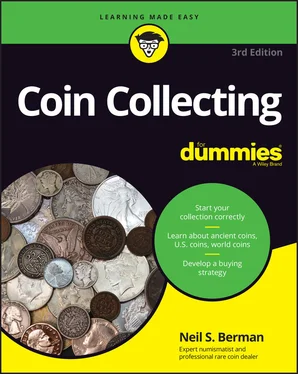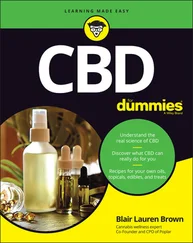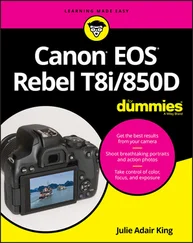Neil S. Berman - Coin Collecting For Dummies
Здесь есть возможность читать онлайн «Neil S. Berman - Coin Collecting For Dummies» — ознакомительный отрывок электронной книги совершенно бесплатно, а после прочтения отрывка купить полную версию. В некоторых случаях можно слушать аудио, скачать через торрент в формате fb2 и присутствует краткое содержание. Жанр: unrecognised, на английском языке. Описание произведения, (предисловие) а так же отзывы посетителей доступны на портале библиотеки ЛибКат.
- Название:Coin Collecting For Dummies
- Автор:
- Жанр:
- Год:неизвестен
- ISBN:нет данных
- Рейтинг книги:4 / 5. Голосов: 1
-
Избранное:Добавить в избранное
- Отзывы:
-
Ваша оценка:
- 80
- 1
- 2
- 3
- 4
- 5
Coin Collecting For Dummies: краткое содержание, описание и аннотация
Предлагаем к чтению аннотацию, описание, краткое содержание или предисловие (зависит от того, что написал сам автор книги «Coin Collecting For Dummies»). Если вы не нашли необходимую информацию о книге — напишите в комментариях, мы постараемся отыскать её.
Coin Collecting For Dummies,
numismatics
Coin Collecting For Dummies
Coin Collecting For Dummies — читать онлайн ознакомительный отрывок
Ниже представлен текст книги, разбитый по страницам. Система сохранения места последней прочитанной страницы, позволяет с удобством читать онлайн бесплатно книгу «Coin Collecting For Dummies», без необходимости каждый раз заново искать на чём Вы остановились. Поставьте закладку, и сможете в любой момент перейти на страницу, на которой закончили чтение.
Интервал:
Закладка:
Out of this carousal of chaos in the barter economy came the first standards of trade. A standard in trade is an item that everyone who trades agrees has a value against which everything else can be judged and then traded. Objects used in this way have included iron bars, seashells (in inland areas where seashells weren’t found), animals, beads, grain, salt, obsidian (volcanic glass), stone arrowheads, andknives, and bone fishhooks. Standards of trade slightly simplified the trading process into a productive and at least somewhat social event.
Next came man's discovery of metal in a natural state. The first of these metals was iron (from meteorites), followed by copper, gold, and silver. These metals were desirable not just because they were great for making tools, but also because of their beauty. Over time, the metals became the most acceptable items for exchange. A man could sell his cow for gold and have something to trade for food the next month. For the most part, these metals were small and convenient to carry and store, making for the first universal medium of exchange.
Still, during each trade, the amount of each metal varied in weight and in pureness. To solve this problem, the natural solution was weighing and marking the value on each piece. Eventually, the local chief took to marking each unit with its value and assigning his mark, indicating its acceptability in trade. Trade expanded to include metal arrowheads, knife blades, and even nails, the direct ancestors of coins as we know them today.
Since the earliest days of coins, tens of thousands of princes, kings, and emperors, as well as an untold number of cities, states, kingdoms, and empires around the world, manufactured coins. Many of them have vanished. But before they disappeared, they minted and issued multiple millions of coins in hundreds of thousands of designs, sizes, denominations, and metals, leaving them for us to find. In fact there are empires that did exist that have only been discovered and identified due to the coinage left behind. The first coin collector undoubtedly appeared along with the first coin. And collecting coins became a social event, as much fun then as it is today.
On Your Mark, Get Set, Go: Starting Your Coin Collection
Coins have been collected by everyone from Roman emperors (Julius Caesar and Trajan) to U.S. presidents (Harry Truman and Thomas Jefferson) to kings (King Victor Emmanuel of Italy , King Farouk of Egypt, and King Louis XVI of France) to millions of commoners like us.
You can join millions of famous and not-so-famous folks of the past and present and have lots of fun collecting coins, but first, you need to arm yourself with some information. Every coin collector builds their collection differently. Some people with little imagination go for the simplest and least interesting coins; others with more derring-do go for complex and confusing ones. The good news: There isn’t one right way to collect coins, so no matter how you go about it, you can have a good time. For an overview of coin collecting, including the whys and hows, turn to Chapter 2.
Before you spend a dime on collecting coins, you need a buying strategy. You need to know how to research the coins you’re interested in, as well as how condition, rarity, supply, and other factors influence the coins’ values. Most beginning coin collectors get hung up on values. Don’t get me wrong: Value is important, but it’s just one of the things you may want to consider when collecting coins. Also important, are discovering which coins interest you and building a collection you can enjoy. I cover all these topics in Chapter 3.
When you’ve decided to give coin collecting a green light, and you’ve set up a plan for building your coin collection, you’ll want to be sure you know how to hold a coin correctly (because if you don’t hold it correctly, you could damage it) and how to store your collection (to keep it safe from all the evils that can befall a coin). Turn to Chapter 4for more information on storing and handling your coin collection, whether it consists of one coin or a hundred.
Eeny, Meeny, Miney, Moe: Deciding Which Coins to Collect
Sure, you could rush out to the nearest coin dealer and fork over a bunch of cash for the first shiny coin you see. But in the trade, a common expression is “Buy the book before you buy the coin.” I recommend getting familiar with what’s out there first. Maybe ancient Greek or Roman coins or coins from the biblical period suit your fancy. Maybe you’re blown away by coins from the Byzantine Empire or mowed down by medieval European coins. You have unlimited choices in these areas alone; turn to Chapter 5for the lowdown.
On the other hand, maybe you’re more interested in modern U.S. coins. If so, you’re not alone. The U.S. Mint has sold coins to millions of people in the past few years. That’s a lot of collectors, so you can count on meeting all kinds of new people and making friends as you build your U.S. coin collection. For more on U.S. coins, check out Chapter 6.
Maybe you’re more interested in collecting coins from around the world than you are in sticking with the red, white, and blue. You can collect by country, by denomination, by date, by size, or by topic. Coins go in and out of style, too — maybe not as fast as fashion trends brands of blue jeans, but there are trends in coin collecting, and as a collector, you should be aware of them. You can find more on this topic in Chapter 7.
Finally, even though you may not think of the word wild when you think of coin collecting, trust me: Numismatics has a definite wild side. If you fancy yourself to be a bit of a rebel, or if you like to tread the road less traveled, all those rare, expensive, odd, and curious forms of money may be just right for you. In Chapter 8, I fill you in on what’s out there, touching on collecting the coins in the best of conditions and investigating all manner of tokens and dies along the way.
I Pledge Allegiance: Turning Your Attention to U.S. Coins
All kinds of coins have been used in the United States, starting with coins that the colonists used before they got together and became a country. Before Thomas Jefferson sat down to try his hand at declaring independence, foreign coins — from France, Great Britain, Ireland, Mexico, and Spain — were used, as were coins made in the colonies themselves.This included Connecticut, Massachusetts, New Jersey, New York, and Vermont. For more on privately made coins, tokens, and medals and the desirable coins of the Continental Congress, turn to Chapter 9.
In Chapter 10, I cover copper and nickel federal coinage, including copper half cents, large cents, small cents, and two cents, as well as nickel three cents and five cents. I bet you’ll discover some denominations that you’ve never heard of before.
Silver coins make up the bulk of U.S. federal coinage prior to 1964. In Chapter 11, I cover 3 cents, half dimes, dimes, 20 cents, quarter dollars, half dollars, and dollars. Almost everyone has seen a silver dollar, but how about a silver half dime or a 20-cent piece?
The balance of U.S. federal coinage made of metal is pretty much confined to gold coins (my personal favorite). In Chapter 12, I discuss $1 gold, Quarter Eagles ($2.50), $3 gold, $4 gold, Half Eagles ($5), Eagles ($10), and Double Eagles ($20). These coins are the royalty of U.S. coinage, and they’re as popular with collectors today as they were with merchants more than 200 years ago.
Coins are made for more reasons than just commerce. In Chapter 13, I cover commemoratives (coins that were made for special reasons), including the new50 State Quarters program and its cousin, the Presidential $1 Coins program.
Интервал:
Закладка:
Похожие книги на «Coin Collecting For Dummies»
Представляем Вашему вниманию похожие книги на «Coin Collecting For Dummies» списком для выбора. Мы отобрали схожую по названию и смыслу литературу в надежде предоставить читателям больше вариантов отыскать новые, интересные, ещё непрочитанные произведения.
Обсуждение, отзывы о книге «Coin Collecting For Dummies» и просто собственные мнения читателей. Оставьте ваши комментарии, напишите, что Вы думаете о произведении, его смысле или главных героях. Укажите что конкретно понравилось, а что нет, и почему Вы так считаете.












